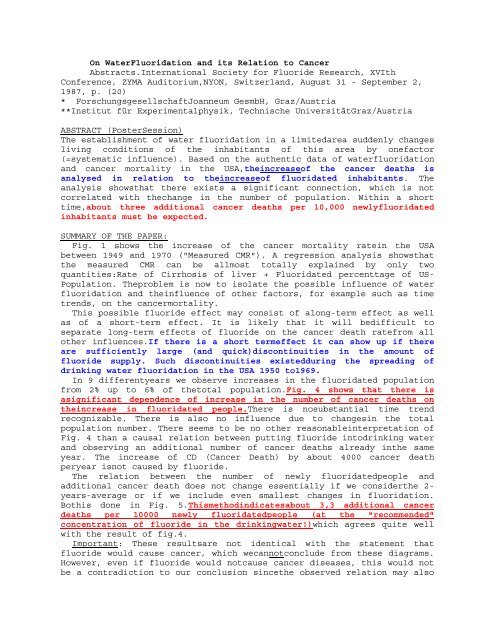"Rudolf Ziegelbecker" To:
"Rudolf Ziegelbecker" To:
"Rudolf Ziegelbecker" To:
Erfolgreiche ePaper selbst erstellen
Machen Sie aus Ihren PDF Publikationen ein blätterbares Flipbook mit unserer einzigartigen Google optimierten e-Paper Software.
On WaterFluoridation and its Relation to Cancer<br />
Abstracts.International Society for Fluoride Research, XVIth<br />
Conference, ZYMA Auditorium,NYON, Switzerland, August 31 - September 2,<br />
1987, p. (20)<br />
* ForschungsgesellschaftJoanneum GesmbH, Graz/Austria<br />
**Institut für Experimentalphysik, Technische UniversitätGraz/Austria<br />
ABSTRACT (PosterSession)<br />
The establishment of water fluoridation in a limitedarea suddenly changes<br />
living conditions of the inhabitants of this area by onefactor<br />
(=systematic influence). Based on the authentic data of waterfluoridation<br />
and cancer mortality in the USA,theincreaseof the cancer deaths is<br />
analysed in relation to theincreaseof fluoridated inhabitants. The<br />
analysis showsthat there exists a significant connection, which is not<br />
correlated with thechange in the number of population. Within a short<br />
time,about three additional cancer deaths per 10,000 newlyfluoridated<br />
inhabitants must be expected.<br />
SUMMARY OF THE PAPER:<br />
Fig. 1 shows the increase of the cancer mortality ratein the USA<br />
between 1949 and 1970 ("Measured CMR"). A regression analysis showsthat<br />
the measured CMR can be allmost totally explained by only two<br />
quantities:Rate of Cirrhosis of liver + Fluoridated percenttage of US-<br />
Population. Theproblem is now to isolate the possible influence of water<br />
fluoridation and theinfluence of other factors, for example such as time<br />
trends, on the cancermortality.<br />
This possible fluoride effect may consist of along-term effect as well<br />
as of a short-term effect. It is likely that it will bedifficult to<br />
separate long-term effects of fluoride on the cancer death ratefrom all<br />
other influences.If there is a short termeffect it can show up if there<br />
are sufficiently large (and quick)discontinuities in the amount of<br />
fluoride supply. Such discontinuities existedduring the spreading of<br />
drinking water fluoridation in the USA 1950 to1969.<br />
In 9 differentyears we observe increases in the fluoridated population<br />
from 2% up to 6% of thetotal population.Fig. 4 shows that there is<br />
asignificant dependence of increase in the number of cancer deaths on<br />
theincrease in fluoridated people.There is nosubstantial time trend<br />
recognizable. There is also no influence due to changesin the total<br />
population number. There seems to be no other reasonableinterpretation of<br />
Fig. 4 than a causal relation between putting fluoride intodrinking water<br />
and observing an additional number of cancer deaths already inthe same<br />
year. The increase of CD (Cancer Death) by about 4000 cancer death<br />
peryear isnot caused by fluoride.<br />
The relation between the number of newly fluoridatedpeople and<br />
additional cancer death does not change essentially if we considerthe 2years-average<br />
or if we include even smallest changes in fluoridation.<br />
Bothis done in Fig. 5.Thismethodindicatesabout 3,3 additional cancer<br />
deaths per 10000 newly fluoridatedpeople (at the "recommended"<br />
concentration of fluoride in the drinkingwater!)which agrees quite well<br />
with the result of fig.4.<br />
Important: These resultsare not identical with the statement that<br />
fluoride would cause cancer, which wecannotconclude from these diagrams.<br />
However, even if fluoride would notcause cancer diseases, this would not<br />
be a contradiction to our conclusion sincethe observed relation may also















